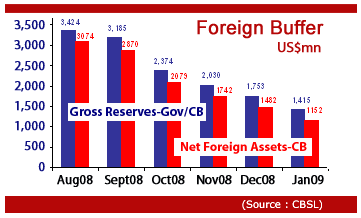buy lexapro online buy lexapro online no prescription
Sri Lanka's gross official reserves, including fiscal balances, fell to 1,415 million US dollars in January from 3.4 billion dollars at the beginning of September.
But net foreign assets of the central bank were much lower at 1,151 million US dollars in January based on an end month exchange rate of 113.85 rupees to the dollar.
In February the central bank had spent 250.49 million US dollars defending a peg with the US dollar at 114.25 rupees, while collecting only 10.
buy wellbutrin online buy wellbutrin online no prescription
50 million, losing 239.99 million US dollars in the process, according to the latest data.

In the same month the Central Bank said it had received 200 million US dollars of short-term funding from Malaysia.
But the peg defence cost in February is higher than the Malaysian borrowing, indicating an estimated net foreign assets figure of around 1,100 million US dollars for February without accounting for exchange rate changes or interest rate accruals.
By March 27, the central bank's Treasury bill stock, which is a proxy for foreign reserves losses as it shows the cost of sterilizing foreign reserve outflows, was 202 billion rupees, up from 179 billion rupees in February 27.
The monetary base was flat at 265 billion rupees from February 26 to March 26. The Treasury bills held by the Central Bank had climbed 22.3 billion rupees or 195 million US dollars during March, indicating that net foreign assets could be around 905 million US dollars now.
An International Monetary Fund team is currently in Sri Lanka to discuss a bailout package for the country.
Before the mission arrived, there were hopes of a deal being wrapped up by the first or second week of April, but an IMF official this week refused to be drawn to a deadline.
To reverse a cycle of outflow sterilization by monetizing government debt (printing money) the country has to float the exchange rate.
Then a process of inflow sterilization has to start to build up foreign reserves by selling down government debt held by the central bank.
But to do that the government - which has more than a 100 ministers - also has to curb fiscal profligacy with the revenues receiving a further blow from a contraction in external trade - especially imports - in January.
